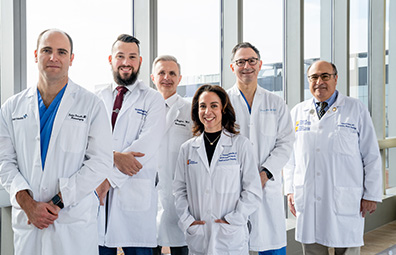Low-Grade Gliomas and Astrocytomas
Gliomas originate from the supportive tissue of the brain (glial cells). There are several types, including astrocytomas. Astrocytomas are named after astrocytes, the star-shaped glial cells which support and regulate electrical impulses in the brain. These tumors are classified into four grades that reflect their degree of severity. Low-grade tumors are slow growing, generally affect young patients and have a good chance of successful treatment.

Meet Our Brain Tumor Care Team
Meet the specialists at the Gerald J. Glasser Brain Tumor Center who are experts in treating low-grade astrocytomas and gliomas.
Meet the TeamTypes
Pilocytic astrocytomas – these grade I tumors are found most frequently in children and young adults.
Diffuse astrocytomas – the most common low-grade astrocytoma, these grade II tumors generally develop in adults.
Symptoms
Symptoms, which may develop over an extended period of time, can include:
- Headaches
- Nausea
- Weakness or numbness in the arms or legs
- Seizures
- Language impairments
- Vision loss
- Gradual mood or personality changes
- Memory loss
Diagnosis
Low-grade gliomas and astrocytomas are diagnosed through a neurological examination followed by a computed tomography (CT) or magnetic resonance imaging (MRI) scan of the brain. MRI scans are usually performed with contrast dye to help identify the tumor’s size, location and type. These tumors tend to be clearly visible on imaging scans.
An exact diagnosis can only be confirmed following a stereotactic biopsy or surgical removal of the tumor. Tissue analysis by a neuropathologist defines the diagnosis and genetic profile of the tumor.
Treatment
Surgery - Treatment for low-grade gliomas and astrocytomas typically starts with surgical removal of the tumor. We use the latest techniques to make craniotomy (surgical opening of the skull) as safe and effective as possible. These include:
- Stereotactic volumetric techniques help the surgeon achieve a near-total removal of the tumor.
- Depending on the location of the tumor, the neurosurgeon may employ advanced techniques to safely remove a tumor even in the parts of the brain that handle speech, vision and movement:
- Functional brain mapping and awake surgery
- 3-D stereotactic image-guided techniques
- High-powered microscopes and fluorescent imaging
Alternatively, laser interstitial thermal therapy (LITT) may be used as a minimally invasive surgical alternative to open craniotomy. Or, a biopsy could be performed in patients with medical conditions that don't allow for surgery – or when there are concerns about the location of the tumor.
Total surgical removal can be a cure for some pilocytic astrocytomas, which have sharply defined edges. However, surgery is combined with additional treatments for other low-grade tumors and diffuse astrocytomas that have spread to surrounding brain tissue.
Once a tumor is removed, the diagnosis and molecular profile is individually reviewed by our multidisciplinary tumor board. Together, our experts recommend the best personalized and targeted treatment options incorporating the latest molecular diagnostics, treatment protocols and participation in national clinical trials.
Post-surgical treatment - The next steps are determined by the exact tumor type and grade, the molecular profile of the tumor and the extent of your removal surgery. Insights from our genetic and molecular analysis of your tumor can help predict responsiveness to chemotherapy and other treatments. Treatments could include:
- Stereotactic radiosurgery (CyberKnife®)
- Image-guided conformal radiation
- Chemotherapy
- Targeted biological therapy
Our team will closely monitor you and personalize your follow-up care. Our care navigator will also connect you with our support group and other resources.